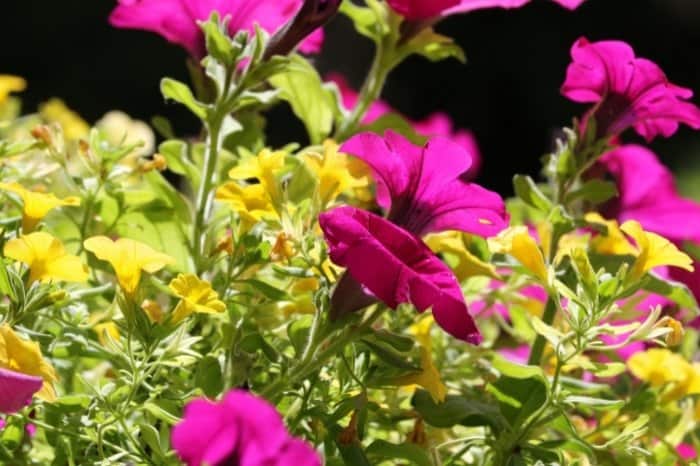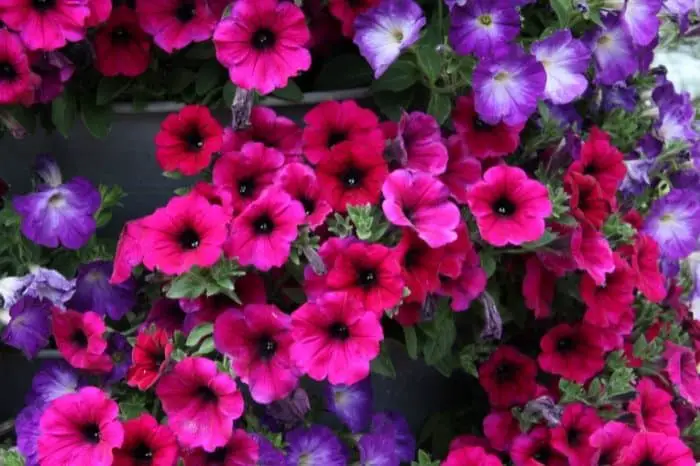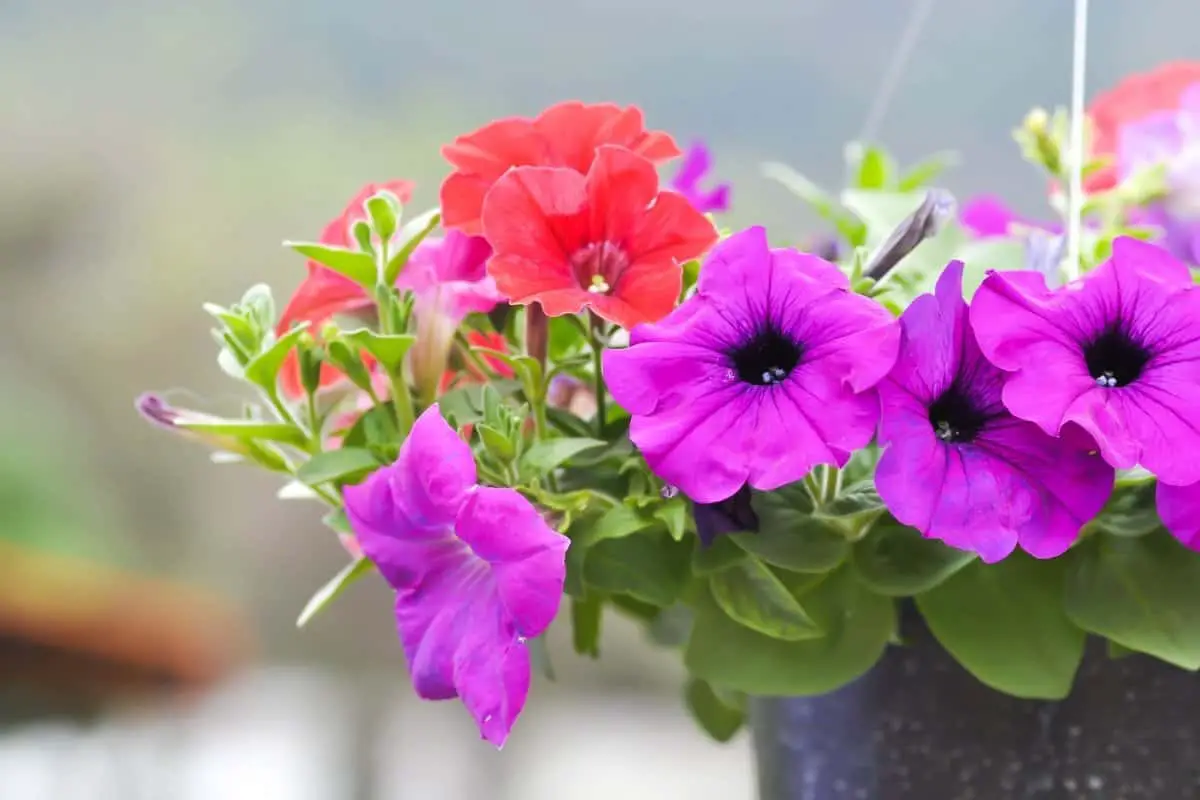Last Updated on February 4, 2022 by
Petunias are among the most popular summer bedding plants but are petunias annuals or perennials?
These compact, bushy petunia plants are perfect for growing in beds and borders. The trailing types brighten up the patios with hanging baskets and flow down the edges of pots.
They flower from early summer until the first severe frosts of autumn begin to fall. Their massive flowers produce lots of color for gardens.
Petunias have many varieties featuring.
- A wide choice of colors
- Single and double blooms
- Ruffled or smooth petals
- Solid single, veined, striped, or picotee-edged colors
- Different fragrance
Are Petunias Annuals Or Perennials
Knowing if these flowers are annuals or perennials helps you understand their needs when growing them in your garden.
Although some varieties like the bedding types are grown as annuals starting from seed each year, petunias are perennials. The trailing varieties like Surfinias are perennial and grow from cuttings or new plants.

Petunias grow all year round in USDA hardiness zones 10 to 11. These beautiful colored flowers grow fast and flower abundantly, making them perfect for adding color to your flower gardens, window boxes, and planters.
If they can’t grow all year round in your area, grow these beauties as annuals for dazzling spring, summer, and early fall color.
Petunias Annuals And Perennials Differences
An annual plant goes to seed after flowering and later dies. This happens in all types of climates.
In frosty areas, petunias act like annuals, dying back with the first cold snap.
Grown in a mild climate, petunias act like perennials and have the ability to grow all year round in the right environment.
They thrive in mild, frost-free winters and summers with low humidity and do not rise above 90 degrees Fahrenheit.
Most locations don’t have these specific requirements; this means petunias commonly grow as warm-season annuals.
J R Peters Inc 52624 Jacks Classic No.1.5 20-6-22 Petunia Feed
Growing Warm-Season Annuals
Plant your petunias outdoors after the last frost date when the soil is warm enough, at least 60 degrees F in the spring.
Plant petunias either as seedlings or start from seeds. If you start them from seed, start them indoors at least 10 to 12 weeks before the spring planting date. This means during winter, start them indoors to make it in time for planting them in spring.
When planting outdoors, choose a spot that gets full sun for at least six hours a day. Use rich, well-draining soils.
If you had old petunia plants, remove them after the first frost and start planning your replanting in the spring.
Growing Perennials In The Warm Climates
In regions that are frost-free and summers tend to get too hot, plant these flowers in the fall.
These will bloom all through the winter and spring months. They will fade or burn out in the summer when the temperatures become hot up to above 90 F.
When these flowers fade and wilt during the hot summer, please remove them and get ready to replant in the fall.
Petunias grow year-round only as a true perennial in areas with cool summers and mild winters.

How To Overwinter Petunias
Petunias can be difficult to keep alive during winter. If you grow yours in pots, bring the containers indoors for the winter months. Do so only when the temperatures drop below 40 F.
If your petunias are growing in a garden, dig out the root ball in the fall before the first frost falls, and transplant them into nursery pots. Keep these indoors in bright lights through the winter. You can use natural light from a window or a grow light. Petunias die when they stop getting the sunlight they need.
Once indoors, water your petunia plants when the soil dries out only. Mist the leaves with water every other day. Keep them at room temperature above 55 F but below 90 F.
Replant the overwintered petunias outdoors in the spring.
Growing Petunias Annuals And Perennials – Planting
Choose an area that receives full sun. Petunias prefer full sun, but during hot summers, they will require some light shade.
They thrive in fertile, moist but well-drained soil. Use plenty of organic matter like well-rotted manure, garden compost, or other soil improvers. If your soil does not drain well, you can add some sandy soil to improve.
Plant your petunias in May or June after the dangerous frost season passes.
Prepare a good-sized planting hole, enough to accommodate petunias rootball. Add a layer of organic matter like the planting compost to the base of the hole and fork it in.
Place the rootball in the ready planting hole adjusting the planting depth. It would be best if you planted it at the same depth as it was originally. Mix the organic matter with the soil on top of the hole and fill it in.
The above planting process is the same if you choose to plant from a seedling.
Water the plant or the seedling well and keep watering as needful. Apply mulch to preserve moisture and keep the weeds away.
Petunias Care
-
Watering – Petunias need regular watering because they have shallow root systems that tend to dry out quickly. Ensure your soil remains well-drained to avoid soggy soil that can cause root rot and yellowed foliage. Petunias growing in containers need more frequent watering, almost every day, especially in the hot weather.
-
Fertilizing – If you like, you can use commercial fertilizers or use organic compost throughout. To keep these flowers blooming vigorously throughout summer, apply a slow-release fertilizer or a monthly dose of liquid fertilizer. Those growing in containers require frequent fertilizing because the nutrients are washed out when watering.
-
Pruning and Deadheading – Pruning depends on the variety you are growing. The traditional types require the most work with frequent deadheading to prevent plants from going to seed. Deadheading occasionally will boost bloom production, creating fuller plants. If your plants start getting leggy and have small, fewer blooms, cut them back to encourage more branching and new growth.

Conclusion
Are petunias annuls or perennials depends on the type you are growing? We have looked at both types and how to grow and care for them.
They are among the easy to grow and maintain flowers, and you cannot resist their bloom that brightens up life both outdoors and indoors.
FAQs
Do petunias come back every year?
Yes. They are perennials. You plant them in spring or fall and they will come back every year, sometimes for decades.
Can you keep petunias over winter?
In theory, you could leave them outside all winter. If you're only growing petunias for looks, then you don't need to worry about bringing them inside. But if you're going to be eating them, you'll want to grow them outside. In the summer, you can put them in a sunny window. But if you're planting a winter crop, you'll need to bring them inside to protect them from frost.
Do they need a lot of sun?
Petunias are pretty sun-loving, but they'll do fine in part shade, or even in shade if they get a good drink of water once a day.
Petunias are hardy, easy to grow and attractive. They will flower for a long time and bloom best when planted in a sunny location and well-drained soil.
Do petunias reseed themselves?
They do. The seed is small and can be easily hidden in the soil, so it’s easy to start them again if they die out. If you do have any leftover seeds from your last planting, take a few into the garden and plant them in new pots. Or you can take cuttings from the flower stems and grow them in a pot of your own. What
How long do they take to bloom?
The answer is “it depends”. When you plant them, you should expect to see flowers the first year. This is the time when they are setting seed. Seedlings have a very short growing season. They must be transplanted into the ground as soon as possible after they emerge. You can expect the plants to be in full bloom in about three weeks.
What do you do with petunias after summer?
The answer is to cut the plants back and divide them. Petunias are annuals that will die down and go dormant in the fall. They can be divided in the spring or in the fall, when their leaves drop. Division is a good way to make more plants from a single plant, especially if you live in an area where space is limited.
When dividing a plant, use a sharp knife and make shallow cuts to separate the plants. Don’t make deep cuts, which may damage the root system. After the new plants have been planted out, water thoroughly and give them a fertilizer boost, then mulch to keep weeds from growing. Fertilize your garden regularly with a complete fertilizer.
Do petunias like rain?
Petunias like moist soil, but not wet. If you water them frequently, they will grow fine. If you water them just once a week, they may do poorly. I would water more often if it looks like it is not going to rain.
Caroline is a gardener who loves to get down to the nitty–gritty of gardening. She proudly proclaims herself as a ‘dirt worshipper‘ and can often be found deep in the garden, covered in soil and singing to her plants. As a self–proclaimed ‘plant whisperer‘, Caroline believes that plants need love and attention just like any other living thing, and she loves to give them both. When she‘s not tending to her garden, you can often find her researching the latest gardening trends, or teaching others how to make their gardens thrive


